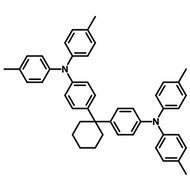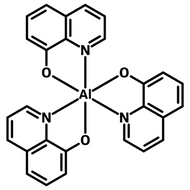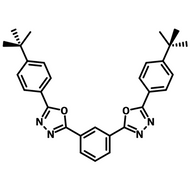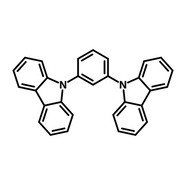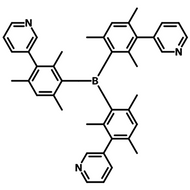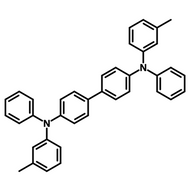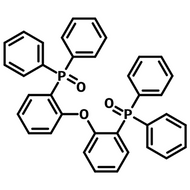OLED Materials

Organic light-emitting diodes (OLEDs) consist of layers of organic materials with charge transport or emissive properties sandwiched between conductive electrodes. OLEDs emit light at a specific color and wavelength, depending on the combination of organic material components. By selecting appropriate host and dopant OLED materials, the emission can be tailored to achieve desired results.
An OLED device has a multilayered system:
Anode | Hole Injection Layer | Hole Transport Layer | Light Emitting Layer | Electron Transport Layer | Electron Injection Layer | Cathode
Thermally activated delayed fluorescent (TADF) materials along with fluorescent and phosphorescent molecules are the three main groups of compounds found in the light-emitting host layer. Emerging fourth-generation materials, such as multi-resonance thermally activated delayed fluorescent (MR-TADF) compounds, are also being explored. Each group of host material has a distinct photoluminescent mechanism, which can be strategically utilized in device architectures.
As OLEDs become more widely used commercially, device efficiency is crucial. One approach is through selecting the appropriate charge transport layer materials with well matched HOMO and LUMO energy levels to the anode and cathode. Additionally, incorporating electron and hole injection layers can significantly enhance the work function and reduce the energy barrier for charge transport at the electrodes.
We offer high-purity OLED materials, including fluorescent, phosphorescent, and TADF host materials, as well as a range of compatible dopant materials and charge transport layer materials, such as electron and hole-injecting materials. Explore our sublimed OLED materials to ensure optimal efficiency in device performance.
Jump to: OLED Materials by Role | Browse all OLED Materials | Resources and Support
OLED Materials by Role
Browse All OLED Materials
Related categories: Charge transport layer materials, Dopant materials, Host materials, TADF materials
Filter by price change:
Filter by charge transport:
Filter by photoluminescence:
Filter by emission color:
Filter by purification technique:
Page 1 of 5
Resources and Support
 Organic Light Emitting Diode: OLED Generations and Structure
Organic Light Emitting Diode: OLED Generations and Structure
An organic light emitting diode is a type of light emitting diode (LED) which using organic materials as the emissive layer. LEDs convert electrical energy into light energy via electroluminescence, and they do this very efficiently. By varying the type of organic materials used, you can easily vary the color of emitted light and efficently optimize the efficiency and stability of your LED device.
Read more...The schematics below show the layout of the substrates along with the available deposition shadow masks. The pixelated anode substrates come with six ITO fingers which define the pixels plus an additional cathode bus-bar.
Read more...Triplet-triplet annihilation (TTA) is an energy transfer process where two molecules in their triplet excited state interact to produce two singlet states: one molecule transitions to its singlet excited state and one molecule transitions to its singlet ground state
Read more...Fluorescence and phosphorescence are types of photoluminescence. Photoluminescence refers to radiative emissions where the absorbance of a photon is followed by the emission of a lower energy photon.
Read more...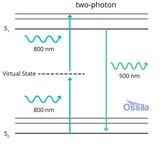 Two-Photon Absorption and Upconversion
Two-Photon Absorption and Upconversion
Two-photon absorption (TPA or 2PA) is a nonlinear optical process in which a material absorbs two photons simultaneously (or within a very short timespan) to excite an electron from a lower-energy state to a higher-energy state. The total energy of the two photons is equal to the energy difference between the two states.
Read more...WOLED is the acronym for white organic light-emitting diodes. White light emission is typically generated from multiple organic emitter molecules with different emission profiles that collectively cover a broad spectral range.
Read more...OLED Fabrication and Testing
 OLED Fabrication Guide
OLED Fabrication Guide
In this guide, we demonstrate how to make standard OLED devices in a glove box using materials and equipment easily available to any lab. Find out more.
Read more... OLED Testing Guide
OLED Testing Guide
This guide gives you an overview of what to consider when characterizing an OLED, as well as tips for their measurement.
Read more...OLED Generations
Hyperfluorescence organic light-emitting diodes (HF-OLEDs) represent the 4th generation of OLED technology. Find out more.
Read more... Multi-Resonance Thermally Activated Delayed Fluorescence (MR-TADF)
Multi-Resonance Thermally Activated Delayed Fluorescence (MR-TADF)
Multiple resonance thermally activated delayed fluorescence (MR-TADF) is a light emitting process engaging the same working principle as thermally activated delayed fluorescence (TADF).
Read more...Thermally Activated Delayed Fluorescence (TADF) is a mechanism by which triplet state electrons can be harvested to generate fluorescence.
Read more...In PhOLEDs, charge carriers are injected from the electrodes into the organic layers, where they recombine in the emissive layer to radiatively emit phosphorescence. Find out more.
Read more...













